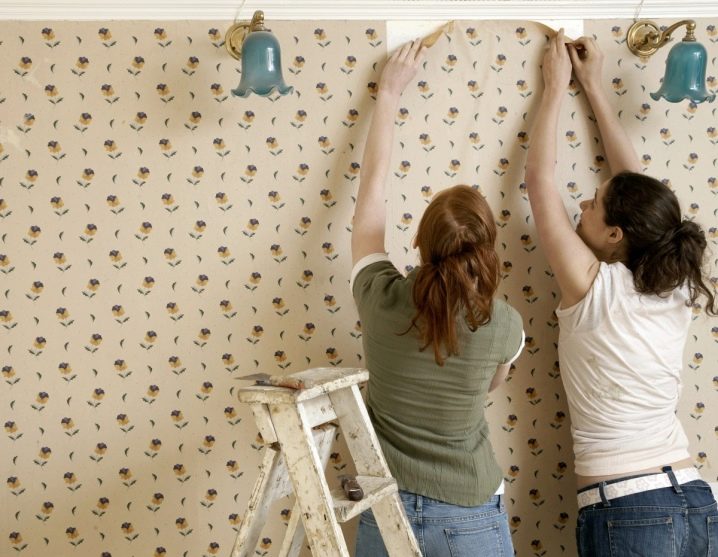Setting loose wallpaper in your room is something that should be done regularly. It is often the case that even if the wallpaper has just been wallpapered, parts of the wallpaper can still peel off. For example, because insufficient glue has been used, the wall is porous, or because the whole does not adhere sufficiently to the wall. So loose wallpaper, even if it’s a few corners, what can you do best in these cases to get it all nice and smooth again?
The wallpaper is coming off, restore and repair the wallpaper
You may be tired of the wallpaper, but if the wallpaper is a bit damaged, re-wallpapering is often not even necessary.  The wallpaper may come off here and there. Often at the seams. This often happens because insufficient glue has been used, or the glue has been made too thin. Another possibility is that the wall absorbs too much, causing the adhesive to adhere insufficiently. So we are going to restore the wallpaper ourselves. How do you do that yourself?
The wallpaper may come off here and there. Often at the seams. This often happens because insufficient glue has been used, or the glue has been made too thin. Another possibility is that the wall absorbs too much, causing the adhesive to adhere insufficiently. So we are going to restore the wallpaper ourselves. How do you do that yourself?
Reading Suggestions:10 Creative And Practical Uses For A Silicon Or Glue Gun
The material you need for loose wallpapering
What do you need for a repair of loose wallpaper? As tools, you need a wallpaper roller, cloth or sponge, a strip of cardboard, and a wide putty knife. As a material, you will of course need wallpaper paste. Do choose the [paste that matches the type of wallpaper that has been used. For paper wallpaper and vinyl wallpaper, for example, this is wallpaper glue for normal to heavy wallpaper, for non-woven wallpaper, non-woven wallpaper glue, and fiberglass wallpaper, you use a separate glue that is applied to the wall and not to the wallpaper itself.
How do you do it yourself Set loose wallpaper.
Now insert the putty knife under the edge and carefully loosen the wallpaper that is not fully attached. Do it so carefully that you do not pierce through the wallpaper and do not tear the wallpaper. Slowly pry it off little by little so you can figure it out later.
Buy wallpaper paste behind the loose wallpaper
Prepare some wallpaper paste and dip the end of a piece of cardboard into it a little so that the glue is on the edge of the cardboard. The glue must be slightly thicker than normal, otherwise, it will not lubricate sufficiently. Now insert the piece of cardboard behind the loose wallpaper and press it firmly. 
Wipe off the wallpaper that is pressed out a little with the damp sponge. Roll the seams with the wallpaper roller to get a firm bond. Wipe it again with a clean damp cloth or sponge. You could also remove the adhesive once it has set, but you risk damaging it.
Blowing into the wallpaper, how do I get rid of it?
Also common are the blisters or vesicles in the wallpaper. They can also be removed as follows. When the wallpaper is dry, make a vertical incision in the middle of the bubble with a hobby knife. If possible, do not cut straight through a motif. Then follow the procedure as described.
Carefully you can open the wallpaper further with a putty knife, press glue behind it with a piece of cardboard, and then press down. Work towards the incision from the sides, so that no air can become trapped. The bladder will disappear like snow in the sun. If the wallpaper is badly damaged, you may be able to replace an entire strip of wallpaper, but pay attention to possible color differences and the pattern. A little latex can also help a lot.
Finally, whitewash the loose wallpaper with latex
Re-wallpapering everything is a lot of work and not everyone is equally good at it. An alternative option is to give your wallpaper a different color and use latex for that, you know that white paint for your wall and ceiling (or latex with a color). Latex is fine to use on the wallpaper, any blisters will disappear when the paint dries. You paint the wallpaper with a paint roller or block brush until the entire wallpaper is done.
Depending on the latex you use, a second turn is sometimes necessary. If you want to be done in one go, use a good covering of latex or wall paint. Make sure you cover your floor well with foil or newspapers because this will prevent splashes on the floor. Anyone can do this and it’s relatively cheap. If there is non-woven wallpaper on the wall, you should ask whether it can also be cleaned.






























